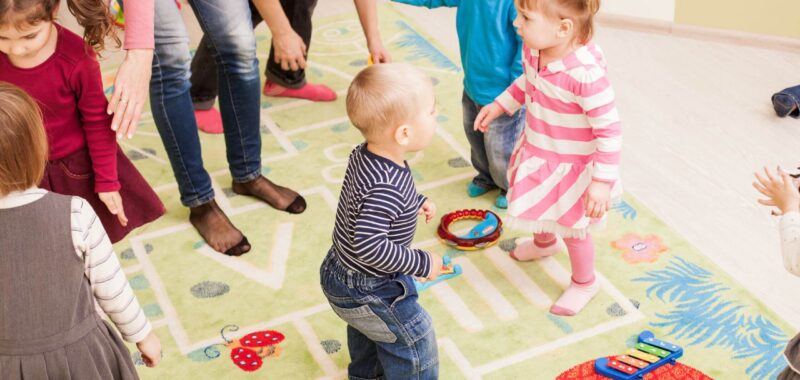In early childhood, development unfolds like a ‘Dance’ across all the emotional, cognitive, and physical domains.
Imagine a dance class where some children follow choreography with ease, while others struggle, but eventually succeed with extra support and adaptation. Similarly, children progress through different developmental stages in their own unique ways. Some may learn by moving sideways, backwards, or forwards, while others might explore zigzags and circles. With proper nurturing, all children move forward at their own pace.
Movement Matters
Children begin laying the essential foundations for movement patterns from the moment of birth—and even before. As they are repeated, these patterns trigger a process where a substance called Myelin wraps around the brain’s neurons (nerve cells). Myelin plays a crucial role in enhancing the speed and efficiency of information processing in the brain. This increased processing speed is vital for developing faster cognitive skills, physical literacy, and language abilities.
Recent research highlights that children with Developmental Language Disorder (DLD) often have reduced myelin in the brain regions responsible for speaking, listening, and learning. This finding underscores the importance of myelin for learning and development throughout childhood, adolescence, and even into adulthood. Therefore, movement and physical activity are not merely about maintaining physical fitness but are critical for cognitive and emotional growth. Movement influences the overall development of the ‘Whole Child,’ encompassing cognitive, emotional, and physical literacy.
Additional Factors
Several factors can impact a child’s ‘dance of development.’ These include low birth weight, stress in the home environment, and individual personality traits. Babies born with low birth weight may experience developmental delays in learning, communication, and physical abilities.
Additionally, the environment and experiences a child encounters can influence their development. Stressful situations at home, such as familial conflicts or economic hardships, can affect a child’s emotional and cognitive growth.
It is important to recognise these factors and address them by creating a supportive and nurturing environment. Focusing on the child’s current abilities, rather than limitations, can foster confidence and motivation.
Celebrate what a child can achieve now and encourage continuous progress in their ‘dance of development.’ This positive reinforcement helps maintain their enthusiasm for learning and development.
Brain-Body Connection
Movement plays a fundamental role in stimulating and nurturing brain development. Incorporating activities that involve coordination, balance, and spatial awareness helps build and strengthen neural connections.
Fundamental movement skills, which start in infancy, are crucial for developing more complex skills needed for daily life and sports.
These skills can be categorised into three main types:
- Locomotor Skills: These include crawling, walking, running, galloping, skipping, jumping, hopping, and rolling. These skills help children explore and navigate their environment.
- Stability (Non-locomotor) Skills: These involve static and dynamic balance, bending, curling, turning, twisting, and stretching. Such skills are crucial for maintaining control and stability of the body.
- Manipulation Skills: These include throwing, catching, kicking, bouncing balls, and handling objects. These skills are essential for interacting with objects and engaging in various physical activities.
Movement And Executive Functioning
Engaging in simple activities, such as dancing, running, or playing games like “Simon Says,” enhances executive functions. These include memory, attention, and problem-solving abilities, which are crucial for overall cognitive development. Movement activities help strengthen these executive functions by providing opportunities for children to practise and refine their skills.
Movement And Language
Movement activities also present fun and engaging opportunities to expand vocabulary and improve communication skills. For instance, describing the actions, feelings, and sensations associated with different movements can introduce children to new words and concepts.
Research indicates that regular physical activity contributes to better language skills and early literacy by enhancing attention spans and cognitive functions. Although the relationship between movement and language development is complex and multifaceted, incorporating it into daily activities can significantly benefit language acquisition and cognitive growth.
Role Of Movement In Learning
Movement plays a crucial role in learning through both unstructured and guided play:
- Unstructured Play: This type of play allows children to explore and discover freely, without rigid rules or guidelines. Playgrounds, outdoor spaces, and open areas are ideal for such play, providing children with endless opportunities to run, jump, explore, and interact with their surroundings. Unstructured play supports the development of fundamental movement skills, cognitive abilities, creativity, imagination, problem-solving, and social skills.
- Guided Play: This approach involves structured activities that target specific movement skills and cognitive outcomes. By focusing on specific skills, educators can tailor activities to align with where a child is in their ‘Dance of Development,’ by providing targeted support to help them progress.
Creating A Movement-Friendly Environment
To promote development, integrate activities into both indoor and outdoor environments. This can include incorporating movement into your daily routines, transitions, and learning areas that encourage movement. Ensure that all activities are accessible to every child, regardless of their ability, or where they are, in their ‘Dance of Development.’
Introducing movement early on enhances cognitive, social, and emotional well-being, develops fundamental movement skills, and supports long-term physical health.
Call To Action
Prioritise movement in your setting and foster the development of fundamental movement skills that will advance your children’s ‘Dance of Development.’
There are numerous ways to incorporate movement into your practise, from creating engaging physical activities to designing movement-friendly environments. The key to supporting each child’s unique developmental journey is to be attuned, adaptable, innovative, creative, and patient.
By focusing on these aspects, you can help choreograph, and nurture, each child’s distinctive ‘Dance of Development,’ ensuring they thrive in all areas of growth.

